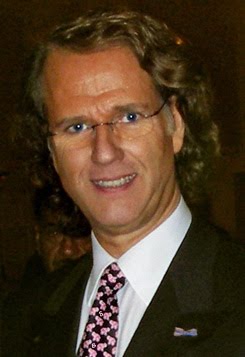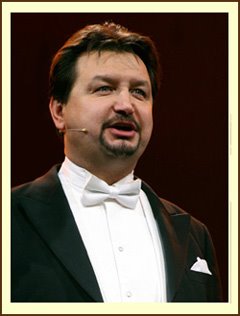The Story Behind The Hit:
"The Second Waltz"
illustration Katinka Hanselman, photo Mitchel Giebels
Golden grip: performance during Champions League match
The Limburger by Rob Cobben: They achieved high ratings in the charts, are a
fixed value in the Top 2000 or Limbo Top 100, or are etched in the collective
memory. In this section we tell the story behind the success numbers of Limburg
soil. Today: "The Second Waltz" by André Rieu.
Sometimes one song can
change your whole life. Take The Second
Waltz, composed by the Russian Dmitri Shostakovitch (1906-1975). André Rieu
adapts it in 1994 with his Johann Strauss Orchestra and scores a world hit with
it. Suddenly everyone knows who the violinist and orchestra leader from
Maastricht is. The album Strauss &
Co, on which The Second Waltz
gets a place, has sold almost a million copies in a year." Just as much as
Michael Jackson's Thriller", says Rieu not without pride in the guest room
of his castle in the Maastricht district of Sint Pieter. "But it took him
two years to do that..." Rieu already knew in the nineties that he has
gold in his hands with his popular renditions of classical music, he says. But
he initially fails to enthuse record companies. "Very frustrating. We went
door to door in Hilversum. But they wouldn't put a label on us. We were not
producing pop and we were not making classical music either. They just didn't
know what to do with us."
Marjorie and
I went every day to V&D (Huge department store chain) to see if there were
still CDs left on the shelves. That was usually not the case: all sold out.
In 1994 he manages to convince the gentlemen of Decca (part of the record group Universal) and was allowed to record the album Strauss & Co with his orchestra. The CD is almost finished when the Maastricht native walks through the corridors of the studio complex in Hilversum and catches fragments of a song from a room that immediately appeals to him. It turns out to be Waltz No. 2 of the Suite for Variety Orchestra, written by Shostakovitch. The composition is a modest hit in France, because there it has been used in an advertisement for an insurance company. Universal is trying to roll out that success in other countries as well.
Champions
League
Rieu immediately adds: "I could use one more song for
the CD," he explains. His wife Marjorie didn't like it at first, says
Rieu, but he immediately saw the potential of the song: "It was nice to
the ear, had a beautiful melody line with that accordion."
Because the original name of the song was not comfortable to the ear, Rieu's wife comes up with the title of The Second Waltz. A few months later – on April 19, 1995 – the semi-finals of the Champions League is being played in the Olympic Stadium in Amsterdam. Ajax (soccer team)will host Bayern Munich. Universal buys airtime to promote the CD of the Maastricht stand-alone violinist during intermission of the match. There are two scenarios: if Ajax is trailing after the first half, a commercial is shown over the CD. But if the Sons of the Gods are in front and the ambiance is good, the violinist will play The Second Waltz live. The latter happens. Ajax goes into the dressing rooms with a comfortable 3-1 lead and Rieu and his violin can take a spot in the middle of the arena. "I had never been to a soccer stadium before," he recalls. "When I was playing in the subterranean passageways, Ajax scored a goal. It was as if the whole tent collapsed. Creepy though..."
Rocket
Millions of Dutch and Germans, who are glued to the tube,
see a little later how the violinist performs The Second Waltz in the sold-out soccer stadium. In the days
following the TV appearances, sales of the album Strauss & Co and the single explode. "Marjorie and I went
to the V&D every day to see if there were any CDs left on the shelves. That
was usually not the case: all sold out. At Universal, they didn't know what was
happening. They had anticipated that we would sell about five thousand CDs, but
by Christmas it was already a quarter of a million..." Rieu's career
skyrockets like a rocket and he's in demand for TV shows. For example, he is
allowed to perform during a benefit show one evening for the victims of the
floods of the Meuse and other rivers. The
top brass of the Dutch showbiz participates in the by Joop van den Ende organized
TV happening. "When we came in, we were ignored by all those colleagues.
But you should have seen those looks when Van den Ende asked us to play The Second Waltz not once, but
twice...." Rieu has now been running a large company with 120 people for a
quarter of a century and has sold more than 42 million CDs and DVDs. The Second Waltz is no longer a regular
part of his shows, because "you can't play the same songs every time."
But on special occasions he still plays it. Like in 2019, during the one hundredth
concert on the Vrijthof. The magic is far from finished, as it turns out to be on
that night. There is swaying and humming
along. There is no end to the applause afterwards...
FACTS
'Waltz No. 2' is part of the so-called 'Suite for Variety Orchestra', a collection of short works which Shostakovich wrote before 1956.
On December 1, 1988, the play was performed in London. That was the first time it could be heard in a Western country.
'The Second Waltz' by André Rieu and his Johann Strauss Orchestra was in the Mega Top 50 for thirty consecutive weeks. No one had achieved that feat until 1994.
But still, that didn't become a record. Marco Borsato made it to 34 weeks with his hit 'Dreams are cheats'.
The album 'Strauss & Co' was on the Album's Top 100 for a year, of which 19 weeks in first place. It became the best-selling CD of 1995.
'The Second Waltz' was in the Top 2000 from 2001 to 2014. The song reached the highest spot in 2007: 615.
André Rieu plays a Stradivarius dated from 1732.
He won the Export Prize of Conamus/Buma seven times.
Thanks John for the translation of this article.





































































































































No comments:
Post a Comment